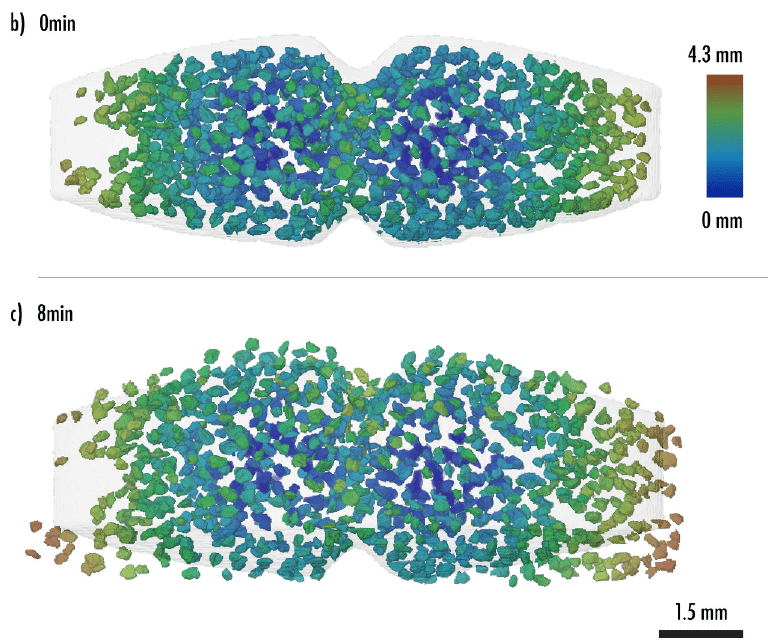The dissolution of coated tablets highlighted by X-ray microtomography
Which phenomena are decisive in oral drug release from…
Accueil » Articles et actualités » Revealing the hidden structure of tablets with synchrotron X-rays
A recent study by Xploraytion, Novitom, Merck, and partners demonstrates how synchrotron X-ray microtomography (SR-µCT) is transforming the analysis of pharmaceutical tablets. Published in the International Journal of Pharmaceutics, the research showcases SR-µCT at the ANATOMIX beamline (Synchrotron SOLEIL), where internal tablet structures can be visualised in 3D – and in real time.
By capturing coating uniformity, porosity and disintegration dynamics within seconds, the team highlights how synchrotron X-rays provide unmatched resolution, speed and sensitivity. Their custom in-situ liquid chamber enables realistic dissolution studies under continuous flow conditions, paving the way for faster, non-destructive quality control and deeper understanding of drug release mechanisms.
Original publication: Static and in-situ synchrotron X-ray microtomography analysis of pharmaceutical tablets – ScienceDirect

Pharmaceutical solid dosage forms, such as tablets, are engineered to deliver drugs at specific rates and to precise sites within the body. Their performance depends critically on structural integrity – from coating uniformity and porosity to the spatial distribution of active pharmaceutical ingredients (APIs). Traditional quality control techniques are often destructive or lack sufficient spatial resolution and sensitivity to characterise these features non-invasively. Laboratory-based X-ray micro-computed tomography (µCT) has become a valuable 3D imaging tool, but it is constrained by limited resolution, lower contrast sensitivity and comparatively long acquisition times.
This study demonstrates how synchrotron radiation-based microtomography (SR-µCT) overcomes these limitations by exploiting the exceptional properties of synchrotron X-rays – extreme brightness, high coherence, and tunable energy – to achieve outstanding spatial and temporal resolution. The work showcases both static and in-situ imaging of pharmaceutical tablets, offering new insights into coating integrity, internal porosity and disintegration dynamics under realistic conditions.
A commercial pantoprazole tablet served as a model system for evaluating the trade-off between field of view (FOV) and resolution. Using voxel sizes ranging from 6.5 µm to 0.65 µm, SR-µCT visualised variations in coating thickness, pore networks, and sub-micron cracks that remain invisible in conventional µCT. The study showed that while low-resolution scans suffice for assessing global uniformity, high-resolution imaging is essential for detecting micro-defects and quantifying coating thickness.

Quantitative analysis confirmed that even small changes in voxel size can influence measured thicknesses by several micrometres. The combination of phase contrast and high sensitivity enabled reliable identification of coating defects and porosity distributions, demonstrating that non-destructive 3D coating inspection of commercial tablets is now achievable with high accuracy.
A major technical advance presented in this work is a custom-designed flow-through liquid chamber that allows in situ SR-µCT imaging of tablets during dissolution under realistic sink conditions. The chamber continuously circulates liquid from a 100 mL reservoir, ensuring homogeneous conditions and full sample rotation. Its spring-loaded pressure system minimises motion artefacts – a significant improvement over conventional static or syringe-based systems.
Using this device, the researchers conducted rapid time-resolved SR-µCT on placebo and commercial tablets (e.g. Beloc Zok) with 5-second tomogram acquisition times, capturing real-time water penetration, swelling and crack formation. At higher resolution (3 µm voxel size), the approach revealed progressive fracture of excipient phases and distinct dual-layer coatings on API granules – structural features unresolvable with laboratory instruments.
Thanks to the high photon flux of the synchrotron beam, the team could continuously track dissolution behaviour over time, eliminating the need to sacrifice multiple samples at different time points. This represents a step change towards true four-dimensional imaging of drug release mechanisms.
Compared with laboratory X-ray sources, synchrotron radiation delivers beams that are millions of times brighter, with superior coherence and precise energy control. These features enable:
As an independent lab, Novitom enables organisations to access synchrotron micro and nano-tomography :
Which phenomena are decisive in oral drug release from…
Why perform microtomography during tensile/compression tests with NOVI CT…
Les images issues de la microtomographie aux rayons X…
Which phenomena are decisive in oral drug release from…
Why perform microtomography during tensile/compression tests with NOVI CT…
Les images issues de la microtomographie aux rayons X…